Gynecologic Emergencies
CLINICAL PICTURE •Vaginal Bleeding I. Speculum Examination:The vagina is full with clots, portio exophytic or shows. Carcinoma crater surface bleeding stronger after touching.II. Palpation:Often large tumor that fills the small pelvis.
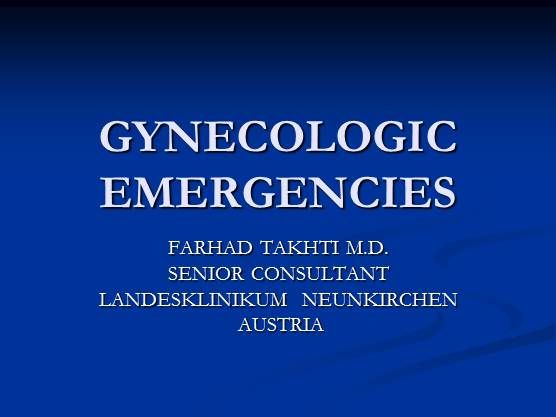
GYNECOLOGIC EMERGENCIES
Farhad Takhti M.D.
Senior Consultant
Landesklinikum Neunkirchen
Austria
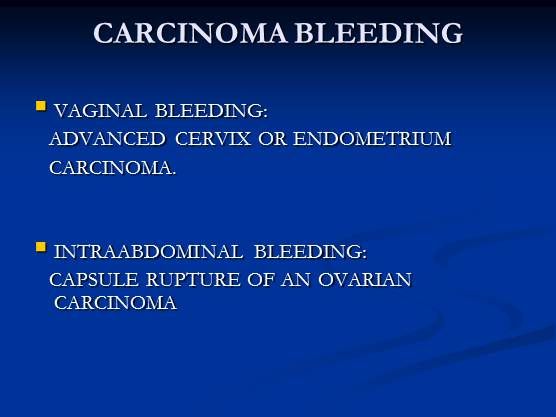
CARCINOMA BLEEDING
• Vaginal Bleeding: Advanced cervix or endometrium carcinoma.
•IntraAbdominal Bleeding: Capsule rupture of an ovarian carcinoma
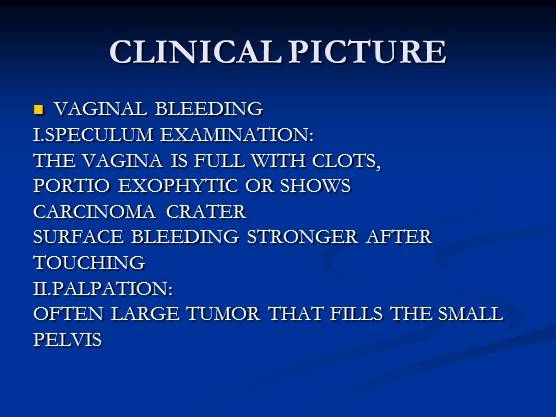
CLINICAL PICTURE
•Vaginal Bleeding
I. Speculum Examination:
The vagina is full with clots, portio exophytic or shows. Carcinoma crater surface bleeding stronger after touching.
II. Palpation:
Often large tumor that fills the small pelvis.
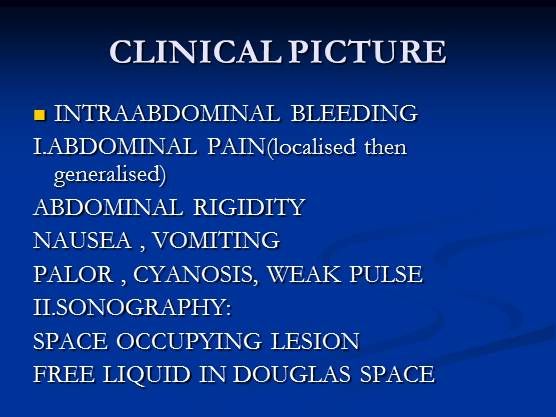
CLINICAL PICTURE
• Intraabdominal Bleeding
I. abdominal Pain (localised then generalised)
Abdominal Rigidity, Nausea, Vomiting Palor, Cyanosis, Weak Pulse
II. Sonography:
Space occupying lesion
Free Liquid in Douglas Space
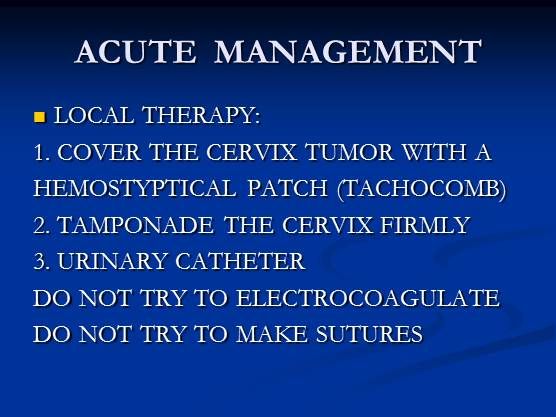
ACUTE MANAGEMENT
• LOCAL THERAPY:
1. Cover the cervix tumor with a hemostyptical patch (Tachocomb)
2. Tamponade the cervix firmly
3. Urinary catheter
Do not try to electrocoagulate
Do not try to make sutures
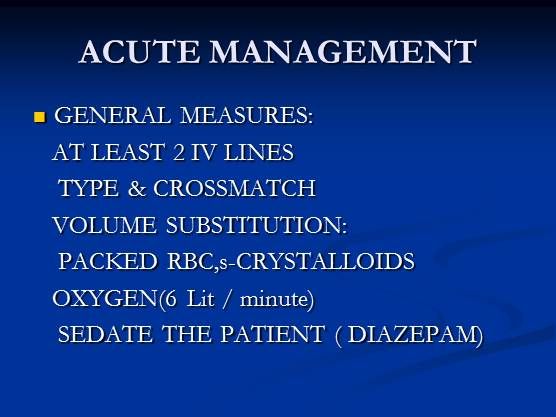
ACUTE MANAGEMENT
• General Measures:
At least 2 IV lines
Type & Crossmatch
Volume Substitution:
Packed RBC,s-Crystalloids
Oxygen(6 Lit / minute)
Sedate the patient (Diazepam)
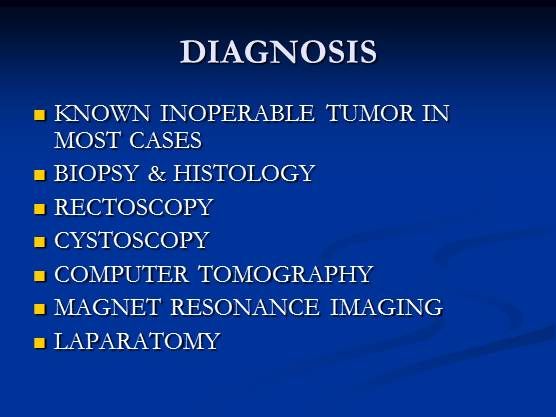
DIAGNOSIS
•Known inoperable tumor in most cases
•Biopsy & Histology
•Rectoscopy
•Cystoscopy
•Computer Tomography
•Magnet Resonance Imaging
•Laparatomy
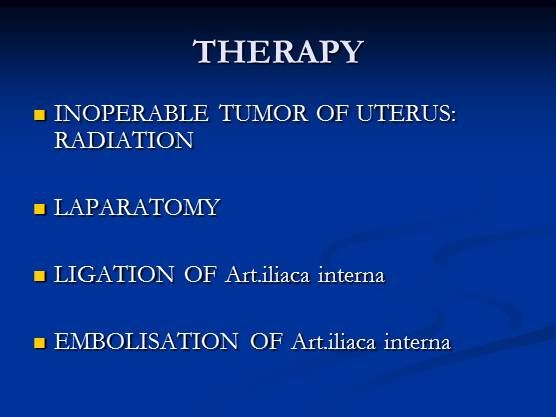
THERAPY
•Inoperable Tumor of Uterus: Radiation
•Laparatomy
•Ligation of Art.iliaca interna
•Embolisation of Art.iliaca interna
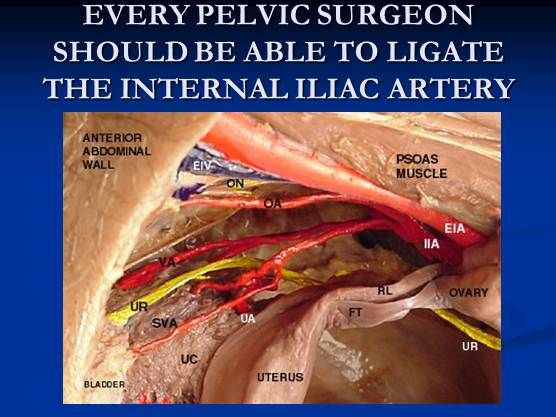
Every pelvic surgeon should be able to ligate the internal iliac artery.

UTERUS PERFORATION
•Simple perforation: Perforation with small Hegar or uterine sound without heavy Bleeding.
•Complex perforation: Perforation of uterus with a large defect by an Abortion forceps.
•Occult perforation: Perforation of parametrium or urinary bladder

UTERINE PERFORATION
•Etiology: hysteroscopy, curettage, IUD insertion.
•Manifestaions:
A. feel no resistance against the instruments.
B. if a large perforation you see the intestine or appendices epiploicae
C. with heavy bleeding the clinical manifestations of shock.

MANAGEMENT
• Stop the operative procedure
• If no active or remarkable bleeding do hysteroscopy; if no bleeding source. Then: observe the patient for 24 hours
• If remarkable bleeding: give uterotonics (Methergin-sulproston) and do laparascopy
• In heavy bleeding-hydatiform mole and endometrium CA: hystrectomy.

GENITAL TRAUMA
• Definition: contusion, scratch, labial tear, penetrating injury through perineum or abdominal wall
• Etiology: fall on the fence or bicycle frame, penetrating trauma, car accidents

SIGNS & SYMPTOMS
• Excoriation, contusion and hematoma of the vulva and mons pubis
• Pain
• Hematuria
• Fecal material through penetration canal
• Bleeding (external-internal)

DIAGNOSTIC
• Exact examination of genitalia
• Sonography
• Computer tomography
• Magnetic resonance imaging
• Cystoscopy
• Coloscopy
• Interdisciplinary cooperation between gynecologist, surgeon urologist, radiologist

COHABITATION INJURY
• Defloration
• Injury due to anatomic anomaly
• Injury due to genital atrophy
• Abnormal sexual practic

RAPE DEFINITION
• The use of physical force, deception, intimidation, or the threat of bodily harm
• Lack of consent or inability to give consent because the survivor is very young or very old, impaired by alcohol or drugs, unconsciousness, or mentally or physically impaired
• Oral, vaginal, or rectal penetration with a penis, finger, or object.

DO NOT FORGET
Rape or sexual intimidation means a massive assault on the personality of the victim. The psychic harms are more serious than the physical injuries.

MANAGEMENT
• Cautious exploration
• Explain the examination steps for the victim
• No doubt on the credibility of the victim
• No individual guilt allocation
• Advise the victim to bring a criminal charge against the committer

EXACT DOCUMENTATION
• Date and time of examination
• Date, time, and scene of the assault
• The course of the assault
• What kind of assault: anal vaginal, oral?
• Did the assailant use condom?
• Did the victim wash herself after the assault?
• Releasing from professional medical secrecy (Police, Attorney, Husband)

DIAGNOSTIC STEPS
• History: LMP; The last sexual intercourse before the assault; contraception; alcohol and other drugs; the victims statement of pain or injuries.
• General condition of the victim: Alcohol? Drugs? Psychological condition of the victim; Are her clothes teared? Dirty? Bloody? Spotted?

DIAGNOSTIC STEPS
• Total Body Examination: See for any injuries especially neck upperarm; wrist; breasts; lower abdomen; thighs.
Hematomas by holding the victim fast on the neck, the inner side of the upperarms and thighs. Note: The hematomas are at the beginning purple or red blue; after 4 days yellow; and after 7 days green brown.

The extra genital injuries are much more common than the genital injuries.
Therefore look for:
Skin bruises
Bite marks
Contusions
Choking signs

FORENSIC MEDICAL EXAMINATION
• Do it after informed consent.
• Should be non-judgmental and objective.
• Includes exact documentation of victim's statements and photodocumentation of injuries.
• Should never take priority over injuries requiring immediate medical care.

PROPHYLACTIC MEDICATIONS FOLLOWING RAPE
• Levonorgestrel 150 mcg or a Copper IUCD
• Ceftriaxon 125 mg IM or Ciprofloxacin 500 mg orally
• Azithromycin 1 G orally
• Tetanus vaccination if indicated
• HIV prophylaxis: Zidovudine 300 mg and Lamivudine 150 mg bid for 28 days
• Hep. B vaccination if the victim is not previously vaccinated

ECTOPIC PREGNANCY
• One of the major causes of maternal death
• Incidence: 2% of pregnancies
• Maternal death rate 0.4/1000 EP,s
• Risk Factors: History of previous ectopic pregnancy, tubal surgery history of PID especially by chlamydia trachomatis

ECTOPIC PREGNANCY
• Consider it in all women of the reproductive age with abdominal pain+vaginal bleeding and in particular if the patient has collaps.
• Consider it strongly if the preg test is positive and there is no uterine gestational sac but free fluid in Douglas Space in vaginal sonography.

LABORATORY DIAGNOSIS
• In a viable intrauterine pregnancy the Β-hCG doubles every 2 days.
• If serial Β-hCG shows an increase of less than 66% in 2 days it is an nonviable pregnancy (ectopic or intrauterine).
• If progesterone level is 25 ng/ml or greater, and ectopic pregnancy could be excluded with a 98% certainty.
• If progesterone level is less than 5 ng/ml, it is a nonviable pregnancy either intrauterine or extrauterine.

HCG and SONOGRAPHY
DO NOT FORGET
• If the Β-hCG level is greater than 1500 mIU/ml and on vaginal US a pregnancy (gestational sac) is not seen it is either an ectopic or failed intrauterine pregnancy.
• In a viable intrauterine pregnancy: You see at
» Β-hCG 1500 mIU/ml: Gestational sac
» Β-hCG 1500 mIU/ml: Fetal pole
» Β-hCG 17000 mIU/ml: Fetal cardiac activity
• Presence of nonclotting blood in culdocentesis supports diagnosis of ectopic pregnancy.

OCCAM,S RAZOR
• Entia non sunt multiplicanda praeter necessitatem.
• Entities must not be multiplied beyond necessity.
• Law of parsimony is also valid for doctors:
• The simplest theory is always the most plausible one, and new theories should be assumed only, if they are absolutely necessary.

DIFFERENTIAL DIAGNOSIS
• Acute appendicitis
• Adnexal torsion
• Abortion
• Corp. Luteum or Foll. Cyst Rupture
• PID
• Degenerating Fibroids
• Endometriosis
• Urinary Tract Infection
• Kidney Stones
• Diverticulosis

TREATMENT OPTIONS
• Medicational: Methotrexate
• Operative therapy:
» Laparascopy:
A. Linear Salpingostomy
B. Salpingectomy
» Laparatomy:
A. Segmental Salpingectomy and Reanastomosis
B. Salpingectomy

METHOTREXATE
• Dosis: 50 mg/ sq m
• Absolute contraindications:
» Active Hepatic or Renal Disease
» Immundeficiency
» Blood Dyscrasias
» Breast Feeding
• RELATIVE CONTRAINDICATIONS:
» Gestational Sac >3.5 cm
» Β-hCG >5000 m IU /ml
» Fetal Cardiac Activity
» Questionable compliance with follow-up

METHOTREXATE PROTOCOL
• Day 0: CBC +BUN +Creatinine + Liver enzymes
Methotrexate: 50 mg/ sq m
• Day 4: Β-hCG Level
• Day 7: Β-hCG Level: If >15% Decline of hCG between day 4 and 7 then weekly control until hCG reaches zero. If <15% decline of HCG repeat methotrexate or consider operative therapy.

OHSS
• One of the major complications of ovulation induction with gonadotropins or clomiphen.
• Patients with PCO syndrome are at increased risk of OHSS if they are given ovulation induction drugs.
• Most cases are mild, but it can be lethal in severe cases.

OHSS CLASSIFICATION
• GRADE 1: Abdominal distention+ discomfort
• GRADE 2: Grade 1 symptoms + nausea vomiting+ / - diarrhoea and enlarged ovaries
• GRADE 3: Above symptoms and ascites
• GRADE 4: Grade 3 + Hydrothorax
• GRADE 5: Grade 4 + Haemoconcentration + Coagulation defects + reduced renal perfusion

OHSS MANAGEMENT
• Control weight and abdominal circumference and fluid balance daily.
• Control these parameters daily: Haematocrit, Electrolytes, E2 Creatinin, BUN.
• In severe cases intensive care unit admission.

OHSS MANAGEMENT SEVERE CASES
• Strict fluid balance
• Central venous pressure line
• Crystaloid solutions as needed
• Colloid solutions if the HCT >45% or in worsening ascites or in severe hypoalbuminaemia
• Low molecular heparin to prevent deep vein thrombosis

OHSS MANAGEMENT
• Do not use NSAIDs because they may impair the renal function that is already affected.
• If analgesics are necessary use paracetamol or opiods or opiates.
• Consider paracentesis and pleurocentesis if the abdomen is very tense or the patient has dyspnea.
• Consider interrupting the pregnancy if the situation life threatening.

DO NOT FORGET
• OHSS usually improves in the luteal phase of the cycle, and resolves within 3 to 6 weeks.
• Severe pain may indicate adnexal torsion or ectopic pregnancy.
• Consider the complications:
» Vascular and cardiovascular
» Hepatic dysfunction
» Respiratory distress due to effusion
» Renal dysfunction
» Adnexal torsion

TOXIC SHOCK SYNDROME
• This highly critical situation should be considered in any young woman with high fever, a widespread rash that looks like a sunburn and desquamates after 7-10 days.
• It is caused by exotoxin of S.AUREUS or erythrogenic toxin of group A or B streptococci

TSS MANAGEMENT
• Examine the patient carefully
• See for any focus of infection for example vaginal tampons and remove these.
• Transfer the patient to intensive care unit.
• Use proper antibiotics: Cefuroxime or Flucloxacillin

PELVIC INFLAMMATORY DISEASE
• Ascending infections: Common
» Vaginal infection results in endometritis salpingitis, adnexitis, pelveoperitonitis, peritonitis, septicemia, septic shock.
» Abortion, delivery, IUD, intrauterine operation
• Descending infections: Seldom
» Per continuation: Appendicitis, Perityphlitic Abscess, Sigmoiditis, Peritonitis
» Hematogenic spread: Tuberculosis

PELVIC INFLAMMATORY DISEASEKEY POINTS
• The two sexually transmitted bacteria responsible for most of cases are C.Trachomatis and N. Gonorrhoea
• Chlamydia trachomatis tends to cause minimal symptoms and can go undetected
• Gonococcal or polymicrobial PID can cause significant destruction of fallopian tubes and development of pyosalpinx or tuboovarian abscess.

ADNEXITIS MANIFESTAIONS
• Acute Adnexitis:
» Sudden abdominopelvic pain
» Fever
» Malodorous yellow - green vaginal discharge
» Nausea, vomiting, flatulence
» Dyspareunia
» Post menstrual bleeding, spotting
» Cervix motion pain

DIFFERENTIAL DIAGNOSIS ADNEXITIS
• Appendicitis
• Extrauterine pregnancy
• Endometriosis
• Collitis Ulcerosa
• Diverticulitis

MANAGEMENT OF PID ACCORDING TO CDC
• Outpatient Treatment:
» Regimen A
Cefoxitin 2 G IM + Doxycyline 100 MG orally two times daily for 14 days +/- Metronidazol 500 mg two times daily for 14 days
» Regimen B
Ofloxacin 400 mg orally two times daily for 14 days +/- Metronidazol 500 mg orally two times daily for 14 days

PID MANAGEMANT
• Inpatient Treatment:
» Regimen A
Cefoxitin 2 G every 6 hours intravenously +/- Doxycycline 100 mg every 12 hourse IV
» Regimen B
Clindamycin 900 mg intravenously every 8 hours +
Gentamycin loading dosis of 2 MG/KG of bodyweight and then 1.5 MG/KG every 8 hours

PIONIERS OF GYNECOLOGY
Hermann Johaness Pfannenstiel
1862-1909
Was born June 28, 1862 in Berlin, receiving his medical degree in 1885. He introduced in 1900 the transverse suprapubic incision of the skin for abdominal operations.

PIONIERS OF GYNECOLOGY
Carl Gustav Carus
1789-1869
Was born January 3, 1789 in Leipzig. He described the pelvic inclination curve.

PIONIERS OF GYNECOLOGY
Hugh Lenox Hodge
1796-1873
Was born, June 27, 1796 in Philadelphia. 1860 he introduced the Hodge pessary for the management of uterine prolapse.

THANK YOU
Friends are generally of the same sex, for when men and women agree, it is only in the conclusions, their reasons are always different.
George Santayana
Recap on reproductive rights with David Hackney, MD, MS
December 20th 2022In this episode of Pap Talk, we spoke with David Hackney, MD, MS, maternal-fetal medicine physician at Case Western Reserve University and chair of ACOG's Ohio chapter for a full recap of where restrictions on reproductive rights have been and where they're going.
Listen
In this episode of Pap Talk, Gloria Bachmann, MD, MSc, breaks down what it means to be a health care provider for incarcerated individuals, and explores the specific challenges women and their providers face during and after incarceration. Joined by sexual health expert Michael Krychman, MD, Bachmann also discusses trauma-informed care and how providers can get informed.
Listen
